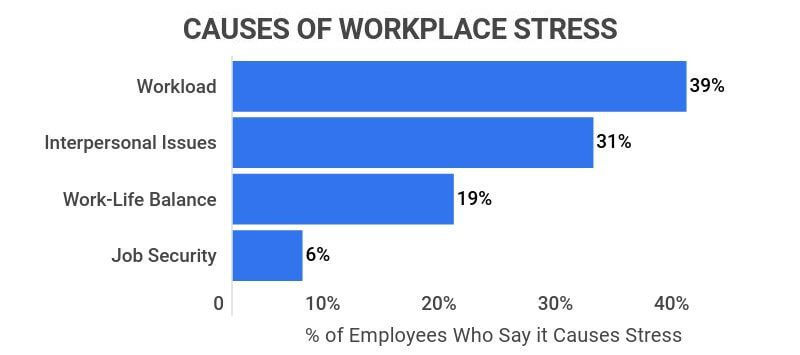Feeling exhausted? Anxious? Over it? You’re hardly alone.
A 2021 survey of 1,500 US workers found that over half (52%) were feeling or experiencing burnout. This number was up from the 43% pre-Covid number and one can only imagine it has gone higher since.
Although work culture has long glamorized extended hours and the “hustle”, the zeitgeist is shifting as we come to realize that working smarter is more productive than simply working harder. Hitting the brakes, being intentional about health, and actively treating burnout is the only way to get back on the road to success and (healthy) productivity.
There are concrete and proven steps that can help. Here’s how to identify work-related burnout and implement coping mechanisms for managing the stress that causes it.
Identifying Burnout
“Burnout” refers to a specific type of stress that is commonly work-related. However, burnout can also apply to other situations involving prolonged periods of stress.
The following symptoms are often used to identify burnout:
- Lower levels of energy
- Reduced productivity
- Negative changes in sleep habits
- Irritability and impatience directed towards others
- Lack of satisfaction in life and at work
- General symptoms of depression and a cynical and critical attitude towards work or relationships that were previously fulfilling or exciting.
In addition, anyone dealing with burnout will often experience physical signs or symptoms such as muscle pains (especially in the back), headaches, and more.
Causes of Chronic Stress and Burnout
Rather than acute stress (a response to short-term stressors), chronic stress occurs when stressors become persistent, unmanageable, or out of our control. Chronic stress can lead to more severe forms of burnout and other major health conditions such as high blood pressure, digestive issues, heart disease, and depression.
Examples of common triggers of chronic stress include debt and finances, overworking, health problems, family responsibilities, and the economy. In 2020 8 out of 10 Americans felt the pandemic had an impact on their stress levels. Workplace stress has also risen since. A recent study found that 25% of US workers listed work as the main cause of stress in their lives with workload and issues with co-workers coming in as top stressors.
Higher levels of stress in the workplace lead to lower productivity. ADAA identified productivity and workplace relationships as the aspects most affected by stress and anxiety. A Lack of energy and focus by anyone working collaboratively means less creative innovation and lower overall quality of output.
Managing Stress: Coping Mechanisms for Burnout and Stress
How do we address the causes of stress? The following coping mechanisms and strategies can help address the symptoms of burnout.
Address the Stressors
Addressing stressors isn’t always easy. An APA study found that those advised by healthcare professionals to make significant lifestyle changes (such as taking time off or quitting smoking) to reduce physical and mental stress were least likely to report success in those changes.
The factors most correlated with making healthy changes and decisions are related to age, socioeconomic status, and the tools we have for dealing with stressors.
Here are some steps for addressing work-related causes of chronic stress:
- List the projects and commitments causing you to feel overwhelmed
- Identify which tasks are non-negotiable
- Cut back on non-essential tasks causing stress
- Say no to accepting more responsibilities until you feel less overwhelmed
Discuss your list with your team, colleagues, or employer to organize a plan of action to address tasks in a manageable way. Can some tasks be delegated? Is everything on your list essential?
Change Your Perspective
It’s not realistic to expect your environment to change significantly. Adaptation is essential in personal evolution. Sometimes, the shift has to come from a new perspective and adjusted attitude. Easier said than done, right?
While it’s not always possible to completely avoid a stressful situation, it is possible to reframe it and reduce the strain. Whether it’s a conflict with a colleague or a significant work stressor, there may be a different way of seeing the problem.
Anchorwoman Robin Roberts teaches an insightful MasterClass on effective and authentic communication. A master of communication, she expounds on the idea that reframing your thoughts and perspectives on tough situations can be as simple as changing the narrative through affirmations. Rather than saying “I have to do this,”, try saying, “I get to do this”.
Another important idea – consider whether you can eliminate the feeling of “should”. Focus on the achievements within your control and think of the bigger picture. Decide whether or not the situation is something that you can realistically let go of.
“We all tend to see things from our limited perspective, but our view of how things ‘should’ be causes most of the suffering in our lives” –Lynne Goldberg
Lower Expectations and Raise the Bar
We’re all hard on ourselves sometimes. A study by Psychological Bulletin found that millennial college students scored higher on socially and self-prescribed “perfectionism” tests than previous generations. That’s great for some situations but can often have very negative stress-related consequences.
Striving for greatness is good; breaking down to get there is not.
There’s a fine balance between raising ambitions and standards while keeping expectations realistic and in check to avoid overworking or burnout. A key to higher job satisfaction is stabilizing expectations. It’s important to know when to power through a task, and when calling it for the day can be more productive in the long run.
"Try not to get lost in comparing yourself to others. Discover your gifts and let them shine!" – Jennie Finch#inspiration #motivation #leadership #coaching #emotionalintelligence #positive #purpose #happiness #believeinyourself pic.twitter.com/sKIOTnuRT7
— Ingeus DE (@ingeusgermany) September 30, 2019
Take a Breath
Be intentional about both rest and movement.
A survey of self-made millionaires found that 76% devote at least 30 minutes per day to exercise. Microsoft founder Bill Gates, for example, starts every day with physical activity such as tennis and ends the day by relaxing with a book. Instagram co-creator Kevin Systrom prioritizes an hour-long bike workout every morning. Oprah Winfrey takes her dogs for a nature walk and drinks decaffeinated coffee.

What form of breathing and movement works for you?
Breathing isn’t simply the practice of breathing, it includes exercise. Daily exercise such as walking, jogging, yoga, gardening, or swimming helps manage stress hormones adrenaline and cortisol. Even leisurely exercise can have a significant impact on your health and productivity.
Besides exercise – breathing, rest, and mindfulness are just as essential for combatting stress.
Breathing exercises can help lower heart rate, reduce blood pressure, and encourage relaxation. Mindful breathing actually helps us tap into neural networks (parts of the brain) that control emotions. A study reviewed by Michigan University MDs revealed deep belly breathing as one of the best ways to lower stress in the body.
Pushing yourself to work six or seven days a week might sound like a go-getter mindset, but taking time to breathe, rest, move, and reset is completely essential for healthier and higher performance.
Ask for Help
Whether you’re just beginning to notice the signs of burnout, or you’re deep in the feelings of overwhelming exhaustion, seek support. A 2021 study of healthcare workers found that social support from a co-worker can potentially mediate cynical emotions and lack of job satisfaction – both with a very big impact on burnout.
Check whether you have access to an employee assistance program that allows you to take advantage of relevant professional resources. From an employer’s perspective, workers utilizing mental health resources can be seen as a glass half full as it encourages better workplace culture, perceived appreciation, and motivation. You may even find yourself capable of exceeding employer expectations.
It can also be beneficial to make use of tools and apps that can help manage the stressors you’ve identified as triggers. There is a wide range of apps dedicated to making your work and personal life more efficient and healthier. Tools and apps ranging from timers for reducing screen time to meditation guides can help manage stress and improve your work-to-life balance. In addition, health and wellness apps can keep your rest and exercise activity on track.
Strategies for Managing Stress and Coping with Burnout
If constant stress is leading to the associated physical and mental symptoms of burnout, these are a few of the concrete steps that you can take to manage your stress.
Whether it’s addressing the stressors, changing your perspective, modifying expectations, asking for help, or finding a healthy and balanced lifestyle, many of us fail to act. And the longer we wait, the more difficult it can be to modify habits.
The burnout might be months and years in the making – so don’t expect to fix it overnight. It’ll take time to remedy – but the sooner you start, the sooner you can expect to see results.
The most important thing to remember is that you’re not alone in the feelings of burnout! This common, work-stress-related condition is avoidable and, more importantly, manageable and reversible.
Disclaimer: Note that this article does not aim to offer medical advice and that you should always speak with a licensed medical professional.
Subscribe to our Newsletter
We send out an email once a month with the latest ideas from our blog and what we’ve been up to.
"*" indicates required fields








